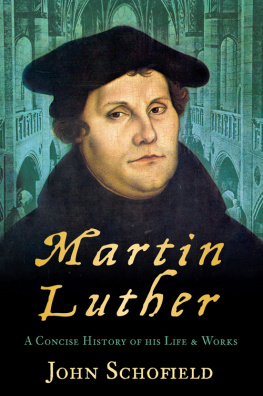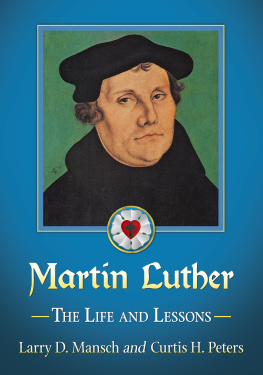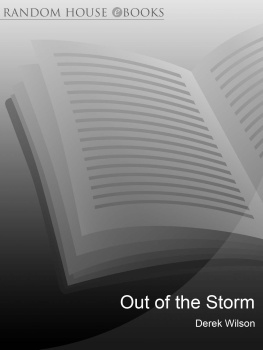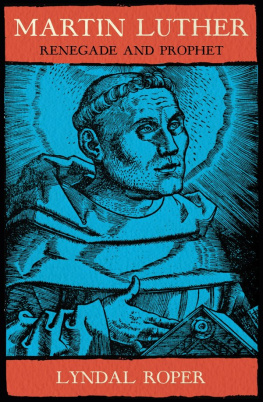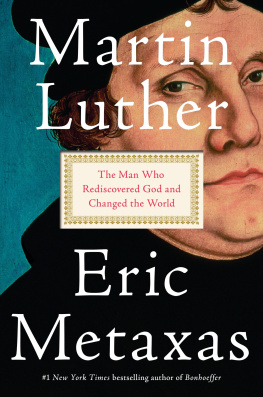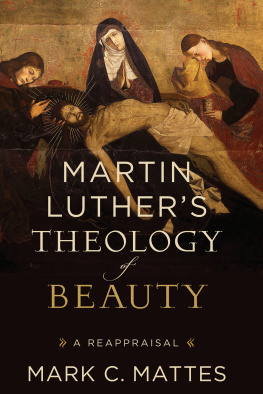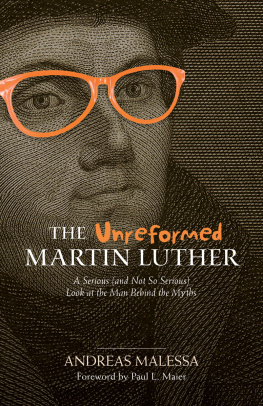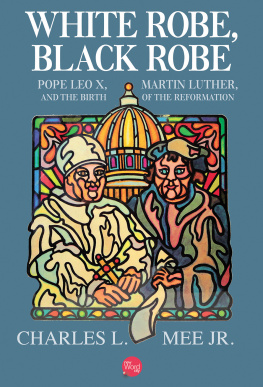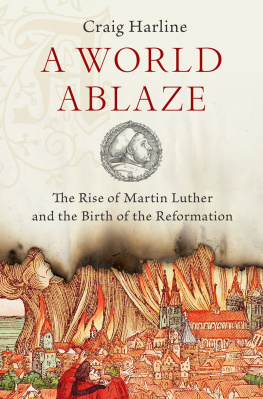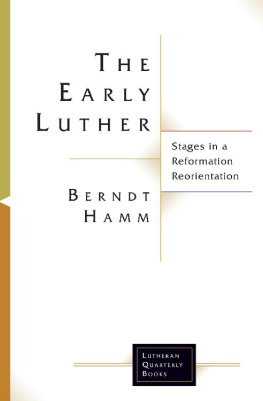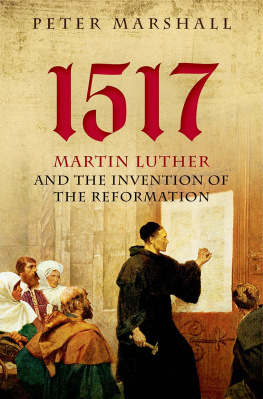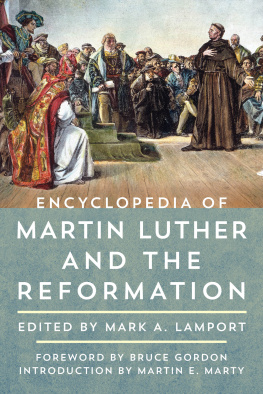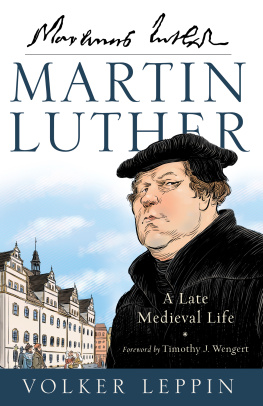
For Charles and Jean
I thank firstly Reverend Ronald Englund, a former pastor of the Lutheran Church of St Anne and St Agnes in London, who, some years ago now, kindly replied to an enquiry of mine concerning Martin Luther, and helped stimulate my interest in him and the Reformation. Secondly, like everyone who has studied Luther, I owe a debt to Jaroslav Pelikan and his colleagues for their labours in producing Luthers Works in English. Thanks also to Newcastle University, and particularly Professor Tim Kirk of the School of Historical Studies, for accepting me as a guest member and visiting scholar, thereby allowing me to do the research for this book; and to the staff of Newcastle and Durham University libraries; and to John Cannon, Emeritus Prof. at Newcastle, for kindly reading through the manuscript and for his many helpful ideas; and to Ashgate Publishing for permission to include two short extracts from my earlier monograph Philip Melanchthon and the English Reformation; and to Simon Hamlet, Abigail Wood and Christine McMorris and their colleagues at The History Press for bringing this work to completion.
Contents
Martin Luther. (Authors Collection)
Luthers house at Wittenberg, the Black Cloister. (Authors Collection)
Frederick the Wise, Elector of Saxony, 1524, after an etching by Albrecht Drer. (Authors Collection)
Charles V, Holy Roman Emperor, after the painting by Titian, engraved by Rubens. (Authors Collection)
Cardinal Wolsey, who ordered the burning of Luthers books. (THP Archive)
Erasmus, by Hans Holbein. (Authors Collection)
The Wartburg. Luther called it My Patmos. (Authors Collection)
Luther as Knight George, from the painting by Cranach. (Authors Collection)
Philip Melanchthon, after an etching by Albrecht Drer. (Authors Collection)
Henry VIII, by Hans Holbein. (THP Archive)
Huldrych Zwingli, after a painting by Hans Asper. (Authors Collection)
Facsimile signatures of the Marburg Articles. (Authors Collection)
Katy Catherine Luther in 1526, from the painting by Cranach. (Authors Collection)
Castle church at Wittenberg. (Authors Collection)
Landgrave Philip of Hesse, after the portrait by Mller. (Authors Collection)
Thomas More, by Hans Holbein. (THP Archive)
Thomas Cranmer, by Gerlach Flicke. (THP Archive)
O f making many books about Luther there seems little end, if I may plagiarise the preacher of old, and until recently it never occurred to me to add to the pile. He has a definitive modern biographer in Martin Brecht, essential reading for serious students of Luther and the Reformation. Shorter books exist as well, the best of which tend to focus on single, specific subjects, like C. Lowell Greens How Melanchthon Helped Luther Discover the Gospel, or David Bagchis Luthers Earliest Opponents. There is much, much more on Luther in library stacks, some good but unfortunately not all, because, more than most reformers, Luther has attracted the unwelcome attentions of the over-opinionated, the moralisers and the amateur psycho-analysts.
The problem was summed up when I was asked a simple question where do I start? The result, because I had copious notes on Luther going back to my student days, is this book. Originally sketched as a simple no frills introduction for students beginning a course on the Reformation at college or university, it later developed into a short biography for a wider readership, but particularly those coming to Luther for the first time. This includes general and lay readers as well as students; indeed anyone who would like a concise but not skimpy history of the principal figure of the Reformation. The material is drawn chiefly from Luthers own writings, and it invites the reader to meet him at his study desk, in the lecture hall, in the pulpit and even at the dinner table.
Regarding terminology, the word evangelical is used in its sixteenth-century sense, meaning Gospel. Terms like Gospel and new learning are used synonymously with the Reformation. Spellings are anglicised and modernised unless stated, and unless there is a pressing reason not to do so.
1
I t may be useful to begin with an overview of the Western medieval Church in which Martin Luther was born and raised, because before he became its most famous reformer, he had been one of its most loyal and obedient sons.
The Church was the body of Christ on earth, the custodian of divine truth and the means of salvation, commissioned to guide the faithful on the way to heaven. The Church existed to teach the flock of Christ to foster devotion to the saints, the Sacraments, fasting, good works and all pious activities. The faith of the Church was drawn from Scripture, the early Christian Creeds, church councils and traditions, though from place to place variations existed in practice, devoutness and even, though on a limited scale, in doctrine.
Salvation was ministered through the Seven Sacraments: Baptism, the Mass, Penance, Marriage, Confirmation, Ordination and Extreme Unction. Through Baptism the newborn child was spiritually reborn to enter the kingdom of heaven, the family of God. When the child became a young adult and reached the age of understanding, he would be confirmed in full membership of the Church. Marriage needs little explanation. By Ordination men were admitted to the sacred priesthood. Such men had to forego marriage and be celibate; or rather, they had to take a vow of celibacy, but how many actually kept that vow remains an unanswerable question. Penance and the Mass will get a more detailed description below. Extreme Unction, the anointing with oil taken from James 5:14, was applied to those about to depart this life and enter eternity.
The medieval Mass was the Churchs re-enactment of the Last Supper and Calvary. The priest recited the Words of Institution used by Jesus at the Last Supper: This is my Body This is my Blood. After this, the consecration of the bread and wine, these elements were transformed into the Body and Blood of Christ through the miracle known as transubstantiation. The priest then lifted the sacred Host the Body of Christ above his head for the adoration of the faithful. He then offered the sacrifice of the Mass for the salvation of souls, the living and also the departed. The priest spoke the sacred words of the service in Latin; and only he could speak them, because those who offered this holy sacrifice had to be specially consecrated, through the Sacrament of Ordination.
Communion was required annually, usually at Easter, though many, particularly the better off, communed more frequently. Normally the laity received the bread only this was called communion in one kind as distinct from communion in both kinds, where communicants received the wine as well. The reasons why one kind had become normal in late medieval times were more practical than theological, motivated mainly by fears of the consequences of spilling the wine, the blood of the Lord. As well as imagery and artwork on the church walls and the ceilings, Mass services were accompanied by candles, ceremony and sacred music. At Corpus Christi Day the consecrated bread was carried through the streets among adoring crowds.
Forgiveness of sins was ministered by the Church through the Sacrament of Penance. The one who sinned had to confess, receive absolution from the priest and usually perform a satisfaction this would be a good work, like giving alms or fasting. Confession was a compulsory annual requirement. Sometimes a satisfaction involved making a pilgrimage to a holy site, perhaps a site with a sacred relic, offering the penitent a sort of encounter with the sacred, enabling them to share in the spiritual and contemplative life of monks and nuns in the monasteries. The penitential system consisted of confession, priestly absolution, works of satisfaction, then restoration to a state of grace. Invariably, some penalties remained outstanding at the moment of death, and these had to be atoned for in the fires of Purgatory before the soul could enter heaven.
Next page
